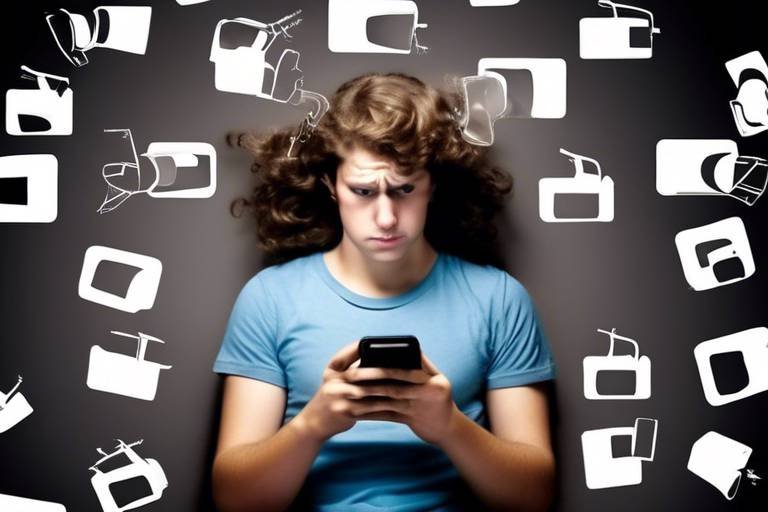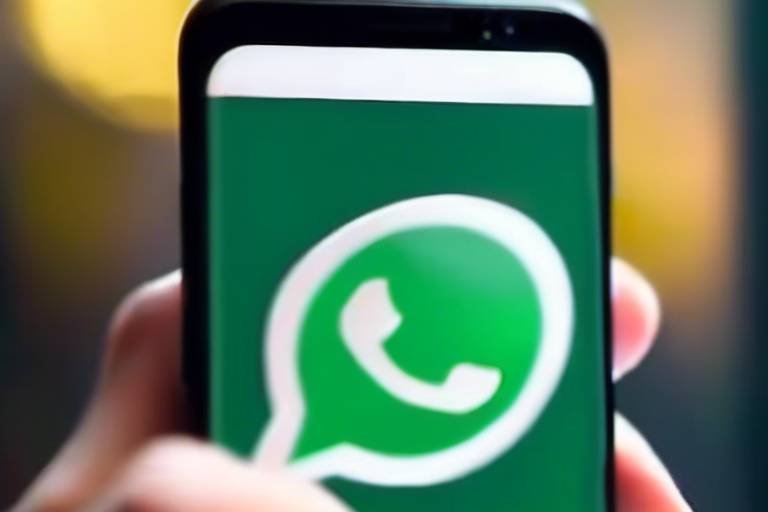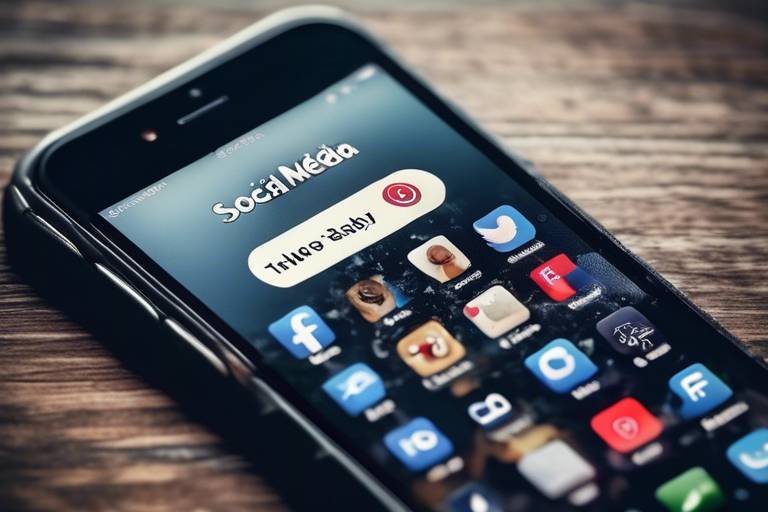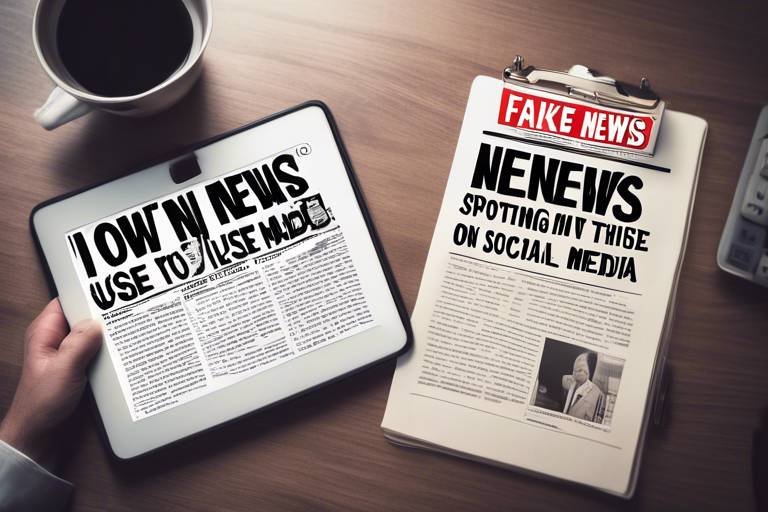The Dangers of Digital Distraction
In today’s fast-paced world, we are constantly surrounded by technology that promises to make our lives easier. However, this digital revolution comes with its own set of challenges, primarily in the form of digital distractions. From the incessant ping of notifications to the endless scroll of social media, these distractions can significantly derail our focus and productivity. But what exactly are these distractions, and how do they impact our lives? Let’s dive deeper into the dangers they pose.
Digital distraction refers to interruptions caused by various forms of technology, including smartphones, tablets, and computers. It’s like trying to have a conversation in a crowded room—your attention is constantly pulled in different directions, making it hard to focus on what truly matters. According to recent studies, the average person checks their phone over 100 times a day, which translates to a staggering amount of time spent reacting to notifications rather than engaging in meaningful tasks. This phenomenon is not just a personal issue; it's a societal one, as more and more individuals find themselves trapped in a cycle of constant connectivity.
The prevalence of digital distractions is alarming. They manifest in various forms, from social media alerts to work emails, and even the temptation to binge-watch the latest series. These distractions are not only pervasive but also deeply integrated into our daily routines. Imagine trying to concentrate on a report while your phone vibrates with messages from multiple apps. It’s like trying to read a book while someone is blasting music in the background. The result? A significant decline in our ability to focus and be productive.
The impact of digital distractions extends beyond mere annoyance; it can lead to serious consequences in both our professional and personal lives. In the workplace, for instance, constant interruptions can result in decreased efficiency and increased errors. Employees may find themselves multitasking—jumping from one task to another—only to realize that they are accomplishing less than if they had focused on one thing at a time. Research indicates that multitasking can reduce productivity by as much as 40%, leaving workers feeling overwhelmed and stressed.
Moreover, the effects of digital distractions on mental health cannot be overlooked. The pressure to remain constantly connected can lead to feelings of anxiety and stress. When we are bombarded with information from all directions, our brains struggle to process it all, leading to what experts call information overload. This overload can make us feel like we are never truly “off,” as there is always something demanding our attention. It’s a vicious cycle: the more we engage with our devices, the more we feel the need to stay connected, often at the expense of our mental well-being.
Finally, let’s not forget about the toll that digital distractions can take on our social relationships. Excessive screen time can lead to disengagement from friends and family, creating misunderstandings and feelings of isolation. Imagine sitting at dinner with loved ones, yet everyone is glued to their screens. It’s a scenario that has become all too common. The irony is that while we are more connected than ever through technology, we often find ourselves feeling more alone. It’s crucial to strike a balance between digital interactions and real-life connections to foster healthy relationships.
In summary, the dangers of digital distraction are multifaceted, affecting our productivity, mental health, and interpersonal relationships. As we navigate this digital landscape, it’s essential to develop strategies to manage these distractions effectively. By being mindful of our technology use, we can reclaim our focus and enhance our overall well-being.

Understanding Digital Distraction
In our fast-paced, tech-driven world, the term digital distraction has become a buzzword that resonates with many of us. But what does it really mean? At its core, digital distraction refers to the interruptions we experience due to our reliance on technology—think smartphones buzzing with notifications, social media alerts popping up, or even the constant temptation to check emails. These distractions are not just occasional annoyances; they are a pervasive part of our daily lives.
To grasp the prevalence of digital distraction, consider this: studies show that the average person checks their phone over 150 times a day. That’s roughly once every six minutes! This staggering statistic illustrates how deeply embedded our devices are in our routines. The forms of digital distraction can vary significantly, from the obvious—like scrolling through social media feeds—to the more subtle, such as the background hum of a news app constantly refreshing. Each of these interruptions pulls our attention away from the task at hand, often leading to a feeling of being overwhelmed.
Moreover, digital distractions can take on many shapes, including:
- Social Media Notifications: Alerts from platforms like Facebook, Instagram, or Twitter can easily derail our focus.
- Email Alerts: The ping of an incoming email can be impossible to ignore, even during critical work tasks.
- Messaging Apps: Instant messages from colleagues or friends can interrupt our flow, making it hard to concentrate.
- Streaming Services: The temptation to binge-watch shows can lead to procrastination and reduced productivity.
As we navigate through our daily responsibilities, it’s essential to recognize how these distractions manifest in our lives. They not only disrupt our concentration but also contribute to a cycle of multitasking that can decrease our overall efficiency. When we attempt to juggle multiple tasks at once, our brains struggle to keep up, leading to more mistakes and a sense of frustration. It’s like trying to juggle flaming torches while riding a unicycle—eventually, something is going to fall!
Understanding the nature of digital distraction is the first step in combating its negative effects. By acknowledging its presence and recognizing the various forms it can take, we can begin to implement strategies to regain control over our attention and focus. In the sections that follow, we’ll explore the impact of these distractions on productivity, mental health, and our relationships, as well as practical strategies for minimizing their effects.
- What are the main causes of digital distraction? Digital distractions are primarily caused by notifications from smartphones, social media, emails, and other online platforms that demand our attention.
- How can I reduce digital distractions? Some effective strategies include setting specific times to check notifications, using apps that limit distractions, and creating a dedicated workspace.
- What are the long-term effects of digital distraction? Prolonged exposure to digital distractions can lead to decreased productivity, increased stress levels, and strained interpersonal relationships.

Impact on Productivity
The impact of digital distractions on productivity is a topic that has garnered significant attention in recent years. With the rise of smartphones, social media, and instant messaging, our work and personal lives have become increasingly intertwined with technology. This constant connectivity often leads to a barrage of notifications and interruptions that can severely hinder our ability to focus. Have you ever found yourself scrolling through social media when you should be working? You're not alone! Many people report feeling overwhelmed by the sheer volume of distractions they face daily.
Research indicates that multitasking—often seen as a skill—is actually detrimental to our productivity. When we attempt to juggle multiple tasks at once, our brain struggles to switch between them effectively, leading to decreased efficiency and increased errors. According to a study conducted by the American Psychological Association, multitasking can reduce productivity by as much as 40%. This staggering statistic highlights just how much digital distractions can derail our efforts to stay on track.
One of the most common sources of digital distraction in the workplace is the incessant ping of emails and messaging apps. Imagine you’re deep into a report, and suddenly, your phone vibrates with a new message. You check it, thinking it’ll only take a moment. But then, you find yourself caught in a web of conversations, losing track of time and focus. This scenario is all too familiar for many professionals. In fact, a survey by the productivity app RescueTime found that more than 60% of employees feel that digital distractions have a negative impact on their work performance.
To illustrate the impact of digital distractions on productivity, consider the following table:
| Type of Distraction | Impact on Productivity |
|---|---|
| Email Notifications | Interrupts focus, leads to context switching |
| Social Media | Time-consuming, promotes procrastination |
| Instant Messaging | Creates a sense of urgency, reduces deep work time |
| Smartphone Alerts | Constant interruptions, increases stress |
As we can see, the various forms of digital distractions contribute to a cycle of reduced productivity and increased stress. But it’s not just about the direct impact on our work; the emotional toll can be just as significant. When we feel overwhelmed by distractions, our stress levels rise, leading to burnout and dissatisfaction with our jobs. It’s a vicious cycle that many find difficult to escape.
So, what can be done to combat these distractions? One effective strategy is to implement structured time management techniques. For instance, the Pomodoro Technique—where you work for 25 minutes and then take a 5-minute break—can help maintain focus while also allowing for necessary downtime. Additionally, setting specific times to check emails and messages can prevent constant interruptions, allowing for deeper concentration on tasks. By taking these proactive steps, individuals can reclaim their productivity and reduce the negative impact of digital distractions on their work and mental well-being.

Workplace Disruptions
In today's fast-paced work environment, the prevalence of digital distractions is more pronounced than ever. Employees are constantly bombarded with notifications from emails, instant messaging apps, and social media, which can lead to significant interruptions throughout the day. Imagine trying to focus on a crucial project while your phone buzzes incessantly with alerts. It’s like trying to read a book in a crowded café—each notification pulls your attention away, making it increasingly difficult to concentrate. This constant disruption not only hampers productivity but also creates a cycle of stress and frustration.
Research indicates that it takes an average of 23 minutes to regain focus after being interrupted. This staggering statistic highlights just how detrimental digital distractions can be in the workplace. When employees are frequently sidetracked by digital noise, they tend to make more mistakes, miss deadlines, and produce lower-quality work. The cumulative effect of these interruptions can lead to a toxic work environment where stress levels soar and morale plummets.
Some of the most common sources of digital distraction in the workplace include:
- Email Notifications: Constantly checking emails can interrupt workflow and lead to fragmented attention.
- Instant Messaging Apps: While these tools are designed to enhance communication, they can often become a source of distraction if not managed properly.
- Social Media: Employees may find themselves scrolling through feeds during work hours, which can detract from their focus on tasks.
Moreover, the culture of multitasking, often glorified in modern workplaces, can exacerbate these disruptions. Employees may feel pressured to juggle multiple tasks at once, believing that this will enhance their productivity. However, studies show that multitasking often leads to decreased efficiency and increased errors. Instead of accomplishing more, employees may find themselves overwhelmed and less effective at their jobs. It's a bit like spinning plates; while it may look impressive, one wrong move can lead to everything crashing down.
To combat these workplace disruptions, organizations must recognize the need for a structured approach to managing digital distractions. This includes setting clear expectations around technology use during work hours, encouraging employees to prioritize focused work periods, and providing tools that help minimize interruptions. By fostering a culture that values deep work and concentration, companies can not only enhance productivity but also improve employee well-being.
In conclusion, acknowledging the impact of digital distractions in the workplace is the first step toward creating a more focused and productive environment. By implementing strategies to minimize these interruptions, both employees and employers can work together to cultivate a culture of concentration and efficiency.

Strategies for Minimizing Distractions
In a world where digital distractions lurk around every corner, finding ways to minimize their impact is crucial for maintaining focus and productivity. One of the most effective strategies is time-blocking. This technique involves dedicating specific blocks of time to certain tasks while eliminating distractions during those periods. Imagine treating your tasks like appointments; by scheduling them in your calendar, you create a commitment to yourself that helps you stay on track. For instance, if you allocate 9 AM to 11 AM for deep work, you can turn off notifications and put your phone away, allowing you to dive into your work without interruptions.
Another powerful approach is to set clear boundaries for technology use. This might mean designating specific times for checking emails or social media, rather than allowing them to interrupt your workflow throughout the day. You could even create a digital detox period where you step away from all devices for a certain time each day. This practice not only helps clear your mind but also allows you to reconnect with your surroundings and the people in your life. After all, isn’t it refreshing to enjoy a meal without the constant buzz of notifications?
Moreover, consider the environment in which you work. A cluttered desk or a noisy background can exacerbate distractions. Creating a designated workspace that is organized and free from unnecessary digital devices can significantly enhance your ability to concentrate. You might also want to explore using focus apps that block distracting websites or limit your usage of specific applications. These tools act like a digital bouncer, keeping unwanted distractions at bay while you focus on what truly matters.
Lastly, fostering a supportive company culture can play a significant role in minimizing distractions. Organizations should encourage employees to communicate openly about their needs regarding focus and productivity. For example, implementing policies such as "no meeting days" or creating quiet zones where employees can work undisturbed can help cultivate an environment that prioritizes concentration. When employees feel supported in their efforts to minimize distractions, their overall performance and job satisfaction often improve.
In conclusion, managing digital distractions requires a mix of personal discipline and supportive environments. By employing strategies such as time-blocking, setting boundaries, organizing your workspace, and fostering a positive company culture, you can reclaim your focus and enhance your productivity. Remember, every small step you take towards minimizing distractions can lead to significant improvements in your work and life.
- What is digital distraction? Digital distraction refers to interruptions caused by technology, such as smartphones, social media, and constant notifications, which can hinder focus and productivity.
- How can I improve my productivity? Implementing strategies like time-blocking, setting boundaries for technology use, and creating a conducive workspace can significantly enhance productivity.
- What are some signs of digital distraction? Signs include difficulty concentrating, frequent checking of devices, and feeling overwhelmed by information overload.
- How does digital distraction affect mental health? It can contribute to stress, anxiety, and feelings of being overwhelmed due to constant connectivity and the pressure to respond immediately.
- Can company culture influence digital distractions? Absolutely! A supportive company culture that prioritizes focus can help reduce distractions and improve employee performance.

The Role of Company Culture
Company culture is more than just a buzzword; it's the very essence of how an organization operates and interacts with its employees. In today's fast-paced digital world, the culture within a company can either exacerbate or alleviate digital distractions. Imagine a workplace where constant notifications and digital interruptions are the norm—it's like trying to swim upstream in a raging river! On the other hand, a supportive company culture can create a serene environment that promotes focus and productivity.
To effectively manage digital distractions, organizations must cultivate a culture that prioritizes focus and mindfulness. This involves not only recognizing the negative impact of excessive technology use but also implementing policies and practices that encourage employees to disconnect when necessary. For instance, companies can establish "no-email" hours, where employees are encouraged to work without the constant ping of incoming messages. This simple change can significantly enhance productivity and reduce stress.
Furthermore, fostering open communication about digital distractions can lead to a more aware workforce. When employees feel comfortable discussing their challenges with distractions, it creates an atmosphere of support and collaboration. Companies can hold regular workshops or training sessions that focus on time management and effective communication, equipping employees with the tools they need to combat distractions.
Another crucial aspect of company culture is the emphasis on work-life balance. Organizations that actively promote a healthy balance between work and personal life tend to see happier, more engaged employees. When employees are encouraged to take breaks, step away from their screens, and engage in non-digital activities, they return to their tasks with renewed energy and focus. This approach not only enhances individual productivity but also fosters a sense of community and camaraderie among team members.
To illustrate the impact of company culture on managing distractions, consider the following table:
| Company Culture Aspect | Impact on Digital Distraction |
|---|---|
| Open Communication | Encourages sharing of distraction challenges and solutions. |
| No-Email Hours | Reduces interruptions, allowing for deep work. |
| Work-Life Balance | Promotes mental well-being, leading to better focus. |
| Mindfulness Initiatives | Teaches employees to manage their attention and reduce stress. |
In conclusion, the role of company culture in managing digital distractions cannot be overstated. By fostering an environment that values focus, communication, and work-life balance, organizations can significantly reduce the negative effects of digital interruptions. This not only enhances productivity but also contributes to a healthier, more engaged workforce. After all, a company that prioritizes its employees' well-being is likely to reap the rewards in terms of loyalty, innovation, and overall success.
Q: How can a company start to change its culture regarding digital distractions?
A: Companies can begin by assessing their current practices, soliciting employee feedback, and implementing small changes, such as establishing no-email hours or promoting mindfulness workshops.
Q: What are some specific strategies employees can use to minimize distractions?
A: Employees can use techniques such as time-blocking, turning off non-essential notifications, and setting specific times to check emails and messages.
Q: How does digital distraction affect team dynamics?
A: Excessive digital distractions can lead to miscommunication, decreased collaboration, and a lack of engagement among team members, ultimately harming team dynamics.

Effects on Mental Health
In our hyper-connected world, where the glow of screens often overshadows the warmth of human interaction, the effects of digital distractions on mental health are becoming increasingly alarming. Imagine waking up and immediately diving into a sea of notifications, emails, and social media updates. This constant barrage of information can lead to a state of perpetual anxiety, where one feels compelled to respond immediately, creating a cycle of stress that is hard to escape. The pressure to stay connected can be overwhelming, making it difficult to focus on what truly matters.
Research has shown that excessive screen time is linked to various mental health issues, including anxiety, depression, and even feelings of loneliness. When we spend more time scrolling through curated lives on social media, we often find ourselves comparing our reality to the highlight reels of others, which can lead to feelings of inadequacy and low self-esteem. It’s like trying to measure your worth against a perfectly filtered image; it’s simply not a fair comparison.
Moreover, the phenomenon of information overload plays a significant role in our mental well-being. With an endless stream of news, updates, and opinions at our fingertips, it’s easy to feel overwhelmed. This can lead to cognitive fatigue, making it challenging to concentrate on tasks that require deep thinking or creativity. The brain, much like a computer, has its limits. When overloaded, it can crash, leading to decreased productivity and increased frustration.
Interestingly, the effects of digital distraction extend beyond individual mental health. Studies indicate that those who frequently check their phones may experience higher levels of stress and a decreased ability to manage emotions. For instance, a survey found that 70% of individuals reported feeling anxious when they couldn’t check their devices, highlighting a growing dependency on technology for emotional regulation.
To better understand the impact of digital distractions on mental health, consider the following table that outlines some common symptoms associated with excessive screen time:
| Symptoms | Description |
|---|---|
| Anxiety | Constant need to check notifications leading to increased stress levels. |
| Depression | Feelings of sadness or hopelessness stemming from social media comparisons. |
| Cognitive Fatigue | Diminished ability to focus or think clearly due to information overload. |
| Sleep Disruption | Difficulty falling asleep due to screen time before bed, affecting overall health. |
So, what can we do to protect our mental health in this digital age? It’s essential to establish boundaries. Designating specific times for checking emails or social media can help reduce anxiety and prevent information overload. Additionally, engaging in activities that promote mindfulness, such as meditation or spending time outdoors, can significantly counteract the negative effects of digital distractions. Think of it as a mental detox—just like your body needs a break from junk food, your mind needs a break from constant connectivity.
In conclusion, while technology has its benefits, it’s crucial to recognize and address its potential impacts on our mental health. By understanding the effects of digital distractions and implementing strategies to manage them, we can reclaim our focus and foster a healthier relationship with technology.
- What are digital distractions? Digital distractions refer to interruptions caused by technology, such as smartphones, social media, and notifications, which can hinder focus and productivity.
- How do digital distractions affect mental health? They can lead to increased anxiety, depression, cognitive fatigue, and disrupted sleep patterns due to constant connectivity and information overload.
- What strategies can help minimize digital distractions? Setting boundaries for technology use, scheduling specific times for checking devices, and engaging in mindfulness practices can help.
- Can digital distractions impact relationships? Yes, excessive screen time can lead to disengagement and misunderstandings among friends and family members.

Social Relationships at Risk
In today's hyper-connected world, where our smartphones are practically glued to our hands, the very fabric of our social relationships is under threat. It's almost ironic, isn't it? We have more ways to connect than ever before, yet many of us feel more isolated. Digital distractions, such as incessant notifications from social media platforms, can create a barrier that prevents genuine interaction. The very act of scrolling through feeds can lead to disengagement from the people physically present around us. Have you ever found yourself at a dinner with friends, yet your attention is solely on your phone? It's a common scenario that many can relate to, and it begs the question: are we truly present in our relationships?
Moreover, the impact of digital distractions extends beyond just feeling disconnected; it can lead to misunderstandings and conflicts. When conversations are interrupted by constant pings and alerts, important points can be missed, and emotions can be misread. For instance, a quick text can be interpreted in multiple ways, leading to unnecessary drama. It’s essential to recognize how these distractions can distort our perceptions of others and create a rift in our communication.
To illustrate the impact of digital distractions on our social lives, consider the following table that outlines some common scenarios:
| Scenario | Impact of Digital Distraction |
|---|---|
| Dinner with Friends | Increased disengagement and lack of meaningful conversation |
| Family Gatherings | Misunderstandings due to distracted conversations |
| Meetings with Colleagues | Decreased collaboration and creativity |
Finding a balance between our digital lives and real-life interactions is crucial. One effective strategy is to set aside specific times for digital engagement, allowing us to focus fully on those around us. For instance, during meals or social gatherings, consider implementing a "phone basket" where everyone can place their devices temporarily. This simple act can foster deeper connections and create a more inclusive atmosphere.
Another vital aspect to consider is the importance of **quality over quantity** in our interactions. Engaging in meaningful conversations, even if they are fewer, can strengthen bonds far more than superficial exchanges conducted through screens. So, the next time you're tempted to check your phone during a conversation, ask yourself: is this moment worth sacrificing for a fleeting digital interaction?
In conclusion, while technology undoubtedly offers numerous benefits, it is essential to remain vigilant about its impact on our social relationships. By consciously managing our digital distractions, we can nurture our connections with friends and family, ensuring that our relationships thrive in this digital age.
- How can I reduce digital distractions during family time? Consider implementing tech-free zones or times, such as during meals or family game nights.
- What are some signs that digital distractions are affecting my relationships? If you notice increased misunderstandings, feelings of isolation, or a lack of meaningful conversations, it may be time to reassess your digital habits.
- Is it possible to balance digital connectivity and real-life interactions? Absolutely! Setting boundaries for technology use and prioritizing face-to-face communication can help achieve this balance.

Balancing Digital and Real-Life Interactions
In today's fast-paced world, where our lives are intertwined with technology, finding a balance between digital engagement and real-life interactions has become crucial. The allure of social media notifications and the convenience of messaging apps can easily pull us into a virtual vortex, making it all too easy to forget the importance of face-to-face communication. Have you ever found yourself scrolling through your phone while sitting across from a friend? If so, you're not alone. Many of us struggle with this modern dilemma.
To cultivate meaningful relationships, it's essential to prioritize real-life interactions. This doesn't mean we should abandon technology altogether; rather, we need to be intentional about how we use it. Here are some strategies to help strike that balance:
- Set Tech-Free Zones: Designate specific areas in your home or during outings where technology is off-limits. This could be the dining table or during family game night.
- Schedule Digital Detox Times: Allocate certain hours of the day to unplug from devices. Use this time to engage in hobbies, read a book, or simply enjoy nature.
- Be Present: When you're with friends or family, put your phone away. Make a conscious effort to listen and engage fully in conversations.
Moreover, acknowledging the impact of excessive screen time on our relationships is vital. Studies have shown that over-reliance on digital communication can lead to misunderstandings and emotional distance. Text messages lack the nuance of voice tone and body language, which can result in misinterpretations. So, why not make it a point to have regular catch-ups over coffee or a walk in the park? These moments can create lasting memories and strengthen bonds.
Additionally, consider the role of technology in enhancing relationships rather than replacing them. Video calls can be a fantastic way to connect with loved ones who live far away, but they shouldn't substitute for in-person interactions. It's all about using technology as a tool to complement our social lives instead of letting it dominate them. By finding this balance, we can foster deeper connections and enrich our lives both online and offline.
Ultimately, the key to navigating this digital age lies in being mindful of our choices. It's about making conscious efforts to engage with the world around us while still enjoying the benefits that technology brings. So, the next time you feel the urge to check your notifications during a conversation, pause for a moment. Ask yourself: is this moment worth more than a quick scroll? Chances are, the answer will be a resounding yes.
Q: How can I encourage my friends to engage in more face-to-face interactions?
A: Start by inviting them to activities that don't involve screens, like hiking, board games, or cooking together. Lead by example and show them the joy of being present without digital distractions.
Q: What are some signs that I might be too distracted by technology?
A: If you find it hard to focus during conversations, often check your phone, or feel anxious when not connected, these may be signs that technology is taking over your interactions.
Q: How can I make my home a more tech-free environment?
A: Implement tech-free zones, have family discussions about device usage, and create a schedule that encourages everyone to unplug during certain times.
Frequently Asked Questions
- What is digital distraction?
Digital distraction refers to interruptions caused by technology, such as smartphones, social media, and other digital devices. It encompasses anything that diverts our attention from the task at hand, often leading to decreased focus and productivity.
- How does digital distraction affect productivity?
Digital distractions can significantly hinder productivity by causing constant interruptions. When we receive notifications or switch between tasks, it takes time to regain our focus, leading to inefficiency and increased errors in both personal and professional settings.
- What are common sources of digital distraction in the workplace?
In the workplace, common sources of digital distraction include emails, messaging apps, social media, and even personal phone calls. These interruptions can disrupt workflow and affect overall employee performance.
- What strategies can help minimize digital distractions?
To minimize digital distractions, consider implementing strategies such as time-blocking, setting specific times to check emails, and creating technology-free zones. Establishing clear boundaries around technology use can help maintain focus and productivity.
- How does company culture influence digital distractions?
Company culture plays a crucial role in managing digital distractions. Organizations that prioritize focus and provide resources for employees to minimize distractions can foster a more productive work environment. Encouraging breaks and promoting a healthy work-life balance are also beneficial.
- What impact do digital distractions have on mental health?
Digital distractions can contribute to anxiety and stress due to constant connectivity and information overload. The pressure to stay updated and responsive can lead to feelings of being overwhelmed, affecting overall mental well-being.
- Can digital distractions affect personal relationships?
Yes, excessive screen time and digital distractions can strain interpersonal relationships. When individuals prioritize their devices over face-to-face interactions, it can lead to disengagement and misunderstandings among friends and family members.
- How can I balance digital engagement with real-life interactions?
Finding a balance involves setting aside dedicated time for in-person communication and being mindful of screen time. Prioritizing quality interactions over quantity can help strengthen relationships while still allowing for digital engagement.


















